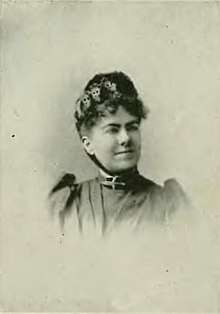Emma Elizabeth Brown
Emma Elizabeth Brown (pen name, B. E. E.; E. E. Brown; October 18, 1847 – ?) was an American author of prose, biographies, and poetry. She was also an artist.[1]
Emma Elizabeth Brown | |
|---|---|
 "A woman of the century" | |
| Born | October 18, 1847 Concord, New Hampshire, US |
| Pen name | B. E. E.; E. E. Brown |
| Occupation | author, artist |
| Language | English |
| Nationality | American |
| Genre | prose, biographies, poetry |
Early years and education
Emma Elizabeth Brown was born in Concord, New Hampshire, October 18, 1847.[2] She was the daughter of John Frost and Elizabeth (Evans) Brown. Her father had no sons, his brother Henry never married, and, her grandfather Brown having been an only son, Emma was the last of her line to bear the family name. As stated by the late Henry Brown, who was a genealogist, this family of Brown in New England was of German origin, and the early spelling of the name was Braun.[3]
Through her paternal grandmother, Mrs. Susannah Frost Brown, Emma traced her descent from Edmund Frost, Ruling Elder of the church in Cambridge, Massachusetts. Elder Frost, said to have been son of John Frost, of Ipswich, England, came over in the ship Great Hope in 1635, and was made freeman at Cambridge, March 3, 1630. He died in July 1672. In his will, which was probated in October following, he left bequests to his widow Reana (his second wife), each of his eight children, something to the new college (Harvard) then building at Cambridge, and to George Alcock, a student.[3]
Emma's father, John Frost Brown, for many years a leading bookseller in Concord, was an ardent lover of beauty, whether in nature or art. During her girlhood, as she took long outdoor tramps with him, he taught her to note the changing beauties of sky and land and sea, which in later years she was skilful in reproducing on canvas. During his busy life, he collected a large library of valuable books.[3] He was a great reader himself, and he directed her reading, which dwelt mostly on outdoor themes and stories of golden deeds in ancient and modern history. This reading bore fruit in the many interesting volumes to which Emma's name was attached. Her mother, Elizabeth Evans, was also of English descent, but her family record shows more practical business men than scholars. She herself had great executive ability and an energetic temperament. Her parents were Artemas and Margaret (Sargent) Evans. The latter, Emma's grandmother, lived to be more than a hundred years old, and when she was ninety-two had four sisters living who were over ninety. Only two of the five, however, reached the century mark, and none of the later generation showed any striking longevity.[4]
The education of the schools, though good, was of less value than that of the home, where the father's greatest pleasure was in opening to his daughters the treasures of his choice library. If from her father she inherited a love of good reading, of pictures and pre-eminently of nature, she was no less indebted to her mother for a certain executive ability, indispensable to success, while from both parents she received constant help and encouragement in her early efforts. During her school-days she sent to the Concord Monitor a poem.[5]
Well-trained in the Concord schools, she was always a student at home and a keen observer as she travelled.[4]
Career
Brown produced contributions for various literary and religious magazines, including the Atlantic Monthly, The Aldine, the Living Age, and others. Her only volume of poems was a brochure entitled A Hundred Years Ago (Boston, 1876). Six volumes of the "Spare Minute Series" were compiled, and five of the "Biographical Series" were of her writing. Her Sunday school books were From Night to Light (Boston, 1872), a story of the Babylonian captivity, and The Child Toilers of the Boston Streets (Boston, 1874).[5] Her magazine stories — many under the pseudonym "B. E. E." — had a grace and tenderness. Her biographies of Washington, Grant, Garfield, and Oliver Wendell Holmes were in steady demand. Huldah, her book of patriotic verse, dedicated to a member of the Daughters of the American Revolution, was read with appreciation by lovers of graceful poetry.[4]
The demand for her water-colors exceeded the supply. At her exhibition in 1892, the favored pictures were scenes at the Azores, where Brown had past vacationed. In 1903, she sketched along the Massachusetts coast,[4] while residing in Newton Highlands.[5]
Selected works
- From Night to Light, 1872
- The Child Toilers of Boston Streets, With Twelve Drawings from Life, by Katherine Peirson, 1878
- The Life and Public Services of James A. Garfield, 1881
- Life of Oliver Wendell Holmes, With a Portrait, 1884
- Life of Ulysses Simpson Grant, 1885
- Life of James Russell Lowell, 1887
- Huldah: A Daughter of the Revolution, and Other Poems of American Patriotism, 1897
References
- Warner 2008, p. 78.
- Willard & Livermore 1893, p. 126.
- Howe & Graves 1904, p. 131.
- Howe & Graves 1904, p. 132.
- Willard & Livermore 1893, p. 127.
Attribution


Bibliography

External links
| Wikisource has original text related to this article: |